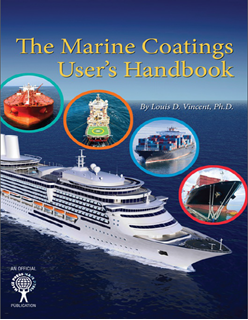Each chapter of The Marine Coatings User’s Handbook is written specifically for personnel involved in both new building and maintenance painting of ships and vessels of all types. At the beginning of the book, author Louis D. Vincent takes the time to familiarize the marine coatings project manager about the difficulties of painting in mobile marine environments.
Ships encounter tremendous stresses as they move through rough sea conditions. So as not to crack under these conditions, they must have a certain degree of flexibility. Therefore, the coatings applied to the hulls, decks, and structural components must also be able to flex through the bends and twists of ocean movement without cracking. Epoxy coatings are modified to attain this flexibility; however, they must be applied within their normal dry film thicknesses (DFT) or the excessive thickness will lead to cracking and delamination.
 Cargo ships do not present any unusual requirements for coating applications, but ballast tanks, potable water tanks, oil tanks, chemical tanks, and other specialty tanks all require great skill to apply coating thickness according to the specification. Edges, corners, angles, and all other fixtures installed in these tanks require special attention for stripe coating and/or edge-retentive coatings.
Cargo ships do not present any unusual requirements for coating applications, but ballast tanks, potable water tanks, oil tanks, chemical tanks, and other specialty tanks all require great skill to apply coating thickness according to the specification. Edges, corners, angles, and all other fixtures installed in these tanks require special attention for stripe coating and/or edge-retentive coatings.
Difficult Areas to Paint
Numerous structural members are necessary to protect the integrity of double bottoms and double sides during collisions and other accidents when large impacts are placed on these areas. Making matters worse is the fact that these compartments are normally quite small in comparison with tanks, so the painter must be quite a contortionist at times to get the proper DFT applied in and around the angles and braces.
Cofferdams are similar to tanks except that they are void areas used to create separate structural supports for the cargo tanks so the tanks can be relatively free of structural members. As with double bottoms, cofferdams are small areas with many structural members, so it is difficult to paint them effectively. There is also the need to ventilate these spaces, which means salty air and high humidity. Painting during the newbuilding process is difficult enough; it is many times more difficult in the maintenance program.
Although pipe racks and cable trays are more easily accessible than cofferdams and double bottoms, the space is always jammed with as much cabling and piping as possible, making it a nightmare to properly prepare the surface and apply the coating system.
Wet bilges are considered the catchalls of everything on the vessel that flows. Being the lowest compartment on the ship, the wet bilge is the last stopping point for anything that is spilled and not thoroughly picked up or dried. It is an even smaller compartment than the cofferdams and double bottoms, and it is extremely difficult to use normal abrasive blasting equipment during the maintenance activities. Normally, special solvent-free epoxy coatings are used during the newbuilding area to achieve 15-year maintenance cycles. Surface-, oil-, and moisture-tolerant epoxies are commonly used when maintenance becomes necessary.
Unique Requirements
As the book gets deeper into the specific challenges of marine coatings, the author does offer particular emphasis on the unique requirements of work processes in a new building shipyard, International Maritime Organization (IMO) Performance Standard for Protective Coatings (PSPC) requirements for ballast tank coatings, corrosion assessment, and mandatory condition surveys required by the various classification societies, the coatings technical file responsibility placed on the coatings inspectors, and computerized monitoring of the coatings application process, along with a selection of inspection equipment.
Source: The Marine Coatings User’s Handbook, store.nace.org.
This article was originally published in the November 2020 issue of Maritime News. Republished with permission.